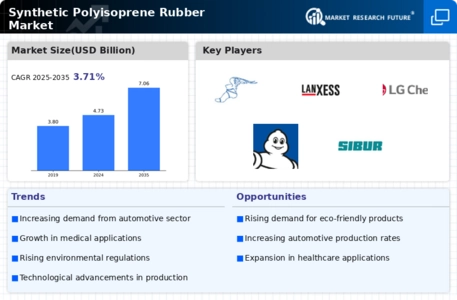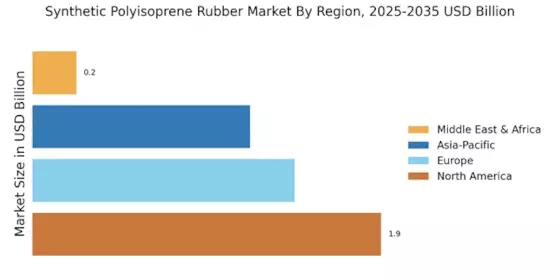Growth of the Automotive Sector
The robust growth of the automotive sector is significantly influencing the Synthetic Polyisoprene Rubber Market. As vehicle production ramps up, the demand for high-performance materials, including synthetic polyisoprene rubber, is expected to rise. This material is particularly valued for its durability and performance characteristics, making it ideal for tire manufacturing and other automotive components. Market analysts project that the automotive industry will continue to expand, with an estimated growth rate of approximately 4% annually. This trend suggests a sustained demand for synthetic polyisoprene rubber, positioning it as a critical material in the automotive supply chain.
Rising Demand for Eco-Friendly Products
The increasing consumer preference for eco-friendly products is a notable driver in the Synthetic Polyisoprene Rubber Market. As environmental awareness grows, manufacturers are compelled to adopt sustainable practices, including the use of synthetic polyisoprene rubber, which is derived from renewable resources. This shift is evident in various sectors, particularly in automotive and consumer goods, where companies are seeking alternatives to traditional rubber. The market for synthetic polyisoprene is projected to expand, with estimates suggesting a compound annual growth rate of around 5% over the next few years. This trend indicates a significant opportunity for manufacturers to innovate and cater to the evolving demands of environmentally conscious consumers.
Regulatory Support for Synthetic Materials
Regulatory frameworks promoting the use of synthetic materials are emerging as a key driver in the Synthetic Polyisoprene Rubber Market. Governments are increasingly implementing policies that encourage the adoption of synthetic alternatives to natural rubber, particularly in sectors where sustainability is a priority. These regulations often include incentives for manufacturers to invest in synthetic rubber production, thereby fostering innovation and growth within the industry. As a result, the synthetic polyisoprene rubber market is likely to benefit from enhanced support, leading to increased production capacities and market penetration in various applications.
Expanding Applications in Diverse Industries
The versatility of synthetic polyisoprene rubber is driving its adoption across a multitude of industries, thereby propelling the Synthetic Polyisoprene Rubber Market. Its unique properties, such as excellent elasticity and resistance to aging, make it suitable for applications ranging from automotive components to medical supplies. The automotive sector, in particular, is witnessing a surge in demand for synthetic polyisoprene rubber for tire manufacturing, with projections indicating a substantial increase in production volumes. Additionally, the healthcare industry is increasingly utilizing this material for manufacturing gloves and other medical devices, further diversifying its application scope and enhancing market growth.
Technological Innovations in Production Processes
Technological advancements in the production processes of synthetic polyisoprene rubber are transforming the Synthetic Polyisoprene Rubber Market. Innovations such as improved polymerization techniques and enhanced processing methods are leading to higher efficiency and lower production costs. These advancements not only increase the quality of the final product but also reduce waste and energy consumption. As a result, manufacturers are better positioned to meet the growing demand for synthetic polyisoprene rubber across various applications, including tires, medical devices, and adhesives. The integration of automation and smart manufacturing technologies is likely to further streamline operations, potentially increasing market competitiveness and profitability.


















Leave a Comment